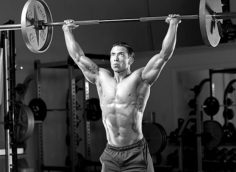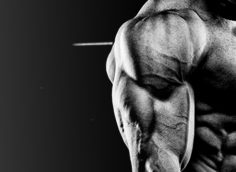Q: When performing power cleans and deadlifts, some people pause at the bottom and take a few breaths between reps, while others hardly let the weight touch the ground – in fact, they may bounce the load off the floor to help them lift it again. Are the latter just using poor form, or is this another variation of the movements?
A: I prefer the first technique in which the bar momentarily pauses on the floor before the next concentric portion because it overloads the posterior chain far better. The ones who use the bouncing approach usually do so because they have a weak lower back.
Pausing also provides a better quality strength and power stimulus as it forces you to overcome inertia on every rep, even though the load on the bar may be lower than what you use with the bouncing approach. And lastly, pausing between reps is also a much safer approach for the spinal column.
Stick to the full range, pausing between reps. You'll be rewarded with greater strength gains and a healthy spine.
Q: My knees collapse when I squat. I heard of a trick where the lifter wraps a belt around his thighs and concentrates on pushing against it while squatting. It's supposed to cure the problem. What's your opinion on this technique? Also, when the knees fall in, is it a problem with strength or flexibility?
A: The creator(s) and proponents of this technique really screwed up on this one. Their interpretation of the knee-buckling problem is that it's caused by weak hip abductors. Then they make you fire your hip abductors while doing an exercise that primarily recruits the hip extensors, thus sending confusing messages to the brain.
Eventually, you'll be forced to use a dinky load that doesn't overload the hip extensor chain properly. You'll develop a brand new faulty recruitment pattern, and you won't fix the real causes of the problem.
I find this technical approach rather idiotic, at best. It doesn't address the real potential sources of the problem, like having a weak vastus medialis and/or adhesions between the adductor magnus and the medial hamstrings. These sort of symptoms are very common in hockey players and figure skaters because of over-recruitment of the vastus lateralis and the overuse of the hip adductor and hip extensors chains.
How do you correct this problem? Well, it goes beyond the scope of this column, as it takes about eight hours of private seminar time to cover. But one thing's for sure, the belt trick won't alleviate the situation. If you want to learn how to solve this and other biomechanical problems, you can either host or come to a private seminar – I only accept up to five people. I will be giving one of these in New York City, Phoenix, and the Bay area in the near future. Email ghursh@hotmail.com if you want to attend or host one of these seminars.
Q: In both your "Poliquin Principles" book and the Top Seven Upper Back Exercises article, you hardly mention barbell rows. Sure, most guys don't perform the movement correctly. But is that a reason to ignore a great exercise? Could you provide a quick primer in barbell rows just in case we get bored of chin-ups?
A: The reason that I didn't mention barbell rows is simply because I don't believe that they're a great upper back exercise, even when performed correctly. Why? Because there's too much neural drive expended in firing the muscles involved in maintaining the postural aspect of the exercise. The body and mind are in high neural gear as they're firing the erector spinae, glutes, and hamstrings at the same time – so much so that the level of recruitment finally left over for the lats is too minimal to be worth it.
That's why I'd rather stick to variations of one-armed rowing exercises. I can hear the "functionalist cult" already arguing, "What about function? This a primary movement." My answer to that is, if you did a good job in the loading parameters for the squat and deadlifting exercises, why overtrain the posterior chain?
Q: It's a fairly accepted rule that lower-rep workouts should contain more sets, and vice versa. Is this always the case? Is there a general rule of thumb for the number of sets and reps performed, or should we just watch the clock and keep workouts to about an hour? I realize that this is very vague, so let's say that we're talking about a genetically average guy who wants to increase his relative strength in order to improve at sports.
A: Yes, it's always the case. Use multiple-joint exercises in maximal-weights training as much as possible. This will increase the probability of neural transfer to whatever sporting movement in which the athlete is involved.
Realistically, however, only one to four exercises can be performed in a relative-strength workout. The higher number can only be achieved if agonists and antagonists are paired. This means doing perhaps a set for chest and following it up with a set for back before performing the second set of the chest exercise.
Alternating agonistic/antagonistic exercise also increases activation of motor units, as long as sufficient rest time is taken. By the way, I used to recommend two minutes between a set of low-rep bench presses and a set of low-rep chins, and another two minutes before going back to bench presses, and so on. Well, through statistical analysis of my athletes's training diaries, I've found that 1:40 was the optimal rest period. It allowed for sufficient recovery without compromising the amount of load lifted.
Lastly, keep the workout time (not including the warm-up) under 45 minutes to an hour. Working out any longer will compromise androgen levels only, which makes it harder to put on muscle and/or recover.
Q: I'd like to test the natural athletic ability of my child, age 12. I've heard that there's a test performed by tossing a ball behind you in an explosive manner that's eerily accurate. I believe that it has something to do with the firing of the nervous system. Do you know of this technique and, if so, could you outline it for us?
A: What you're referring to is the caber toss. This throw was chosen as the best predictor of general athletic ability by the physical education systems of all of the Germanic countries. My own tests verified this concept with sports as varied as luge, volleyball, sprinting, and judo. I even know of a study in which it correlated strongly with the ability to learn windsurfing skills.
The test involves throwing balls of three different weights backward and measuring the shape of the curve of the testing results. Depending on the age and level of qualification of the athlete, the weight of the balls will vary, but they're always spread apart evenly. For example:
- 2 pounds, 4 pounds, 6 pounds
- 8 pounds, 12 pounds, 16 pounds
Theoretically, you would throw the two-pound ball further than the four-pound ball, and the four-pound ball further than the six-pound ball.
One national team hired me to help trim off the fat of their budgets. They wanted to know exactly which athletes had the most potential and, consequently, in which ones should they invest their time and money.
The first test that I administered was the caber test. It turns out that many of their senior national team females had no distinct differences in distances between the different loads. These same athletes, despite having improved their strength dramatically, couldn't show improvement on their track start times. If you score poorly on this test, your athletic potential is rather limited. Therefore, we saved the government plenty of money and allowed them to devote resources to younger athletes who eventually turned out to be Junior World Cup medals winners.
Q: Okay, big fellow, I'm throwing myself at your mercy and begging for forgiveness. I just can't do front squats. I find them uncomfortable and almost drop the damn bar after a few reps. I learned how to do them from Shawn Phillips' article in Muscle Media. He suggested crossing your arms and holding the bar upright, using your closed fists where the bar is resting near the knuckles. Is this right? Also, would one of those blue plastic thingies or some similar device help?
A: In my opinion, the grip that you're referring to is, in fact, quite dangerous. I've seen two separate incidents in which the trainee reached a point of isometric fatigue in the rhomboids and progressively dropped the elbows throughout the set. With sweat acting as a lubricant, the bar rolled down and fell on the poor guy's quadriceps when he hit the bottom position of the squat. Then the bar bounced backward toward the trainee's gut, who then had to do an explosive limbo maneuver to squeeze under the bar.
Needless to say, you can bet that the MRI reading of the poor guy's knees and spine was quite horrifying. And that's not even taking into consideration the nice hematomas on the quadriceps and the trauma caused to the overstretched abs and hip flexors.
I believe that the Olympic lifter's grip is the only right way to do front squats. Be sure to always keep the elbows up and in. If you feel as if you're choking in this position, you're doing it right!
To achieve this self-strangulating position, you have two choices:
- Increase flexibility: You should pay attention to increasing the tissue length of the wrist flexors and the external rotators of the humerus. To learn this, consult a good stretching book or video. Or get Active Release Techniques (ART) done on those structures. To contact an ART practitioner in your area, call 719-473-7000.
- Use straps: If your arms are too large or lack the flexibility, you can use straps as in the method outlined in the photo below. I learned this trick from former Canadian national weightlifting coach Pierre Roy.
In this manner, if you get in trouble, you can pull downward and forward on the straps while shooting the hips back and up. That will allow you to dump the bar in front of you and only damage the floor, not your musculo-skeletal system.
The blue thingy that you refer to is a Sting Ray, which can be purchased at qfac.com or by calling 888-79-SPRAY. Sting Rays allow for a greater surface for distributing the weight, which makes the exercise way more comfortable. Even f you choose to use a Sting Ray, I'd still recommend using straps.





